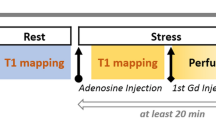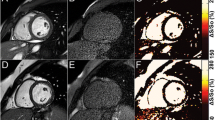Abstract
To evaluate multivoxel 31P-MR spectroscopy (MRS) for assessment of energy metabolism in patients with myocardial infarction (MI) in correlation to left ventricular (LV) wall thickness and the outcome of revascularization. Thirty patients with subacute anterior myocardial infarction and planned revascularization were enrolled. 3D–chemical shift imaging was applied to determine PCr/ATP ratios in two areas: infarcted/anterior and noninfarcted/septal myocardium. MRI was used to evaluate LV function and wall thickness, and was repeated 6 months after revascularization to assess myocardial viability. Fifteen volunteers were controls. Fifteen patients showed normalization of wall motion abnormalities after revascularization (Group 1; viable), 15 not (Group 2; non-viable). Regarding infarcted/anterior myocardium, Group 2 had lower PCr/ATP ratios (0.81 ± 0.60 vs 1.17 ± 0.25), and PCr/ATP ratios were reduced in both groups compared to controls (1.45 ± 0.29). Regarding noninfarcted/septal myocardium, again Group 2 had lower ratios (0.93 ± 0.53 vs 1.31 ± 0.38); however, compared to controls (1.51 ± 0.32) a reduction of PCr/ATP ratios was only found in Group 2. For both myocardial regions, no correlations between PCr/ATP ratios and LV wall thickness were detected. The more severe energetic alteration in irreversibly damaged myocardium is not an effect of differences of wall thinning. Additional alterations of noninfarcted, adjacent myocardium can be detected.




Similar content being viewed by others
References
Bester AJ, Bajusz E, Lochner A (1972) Effect of ischemia and infarction on the metabolism and function of the isolated, perfused rat heart. Cardiovasc Res 6:284–294
Beer M (2004) Cardiac spectroscopy: techniques, indications and clinical results. Eur Radiol 14:1034–1047
Von-Kienlin M, Rosch C, Le-Fur Y, Behr W, Roder F, Haase A, Horn M, Illing B, Hu K, Ertl G, Neubauer S (1998) Three-dimensional 31P magnetic resonance spectroscopic imaging of regional high-energy phosphate metabolism in injured rat heart. Magn Reson Med 39:731–741
Bottomley PA (1985) Noninvasive study of high-energy phosphate metabolism in human heart by depth-resolved 31P NMR spectroscopy. Science 229:769–772
Yabe T, Mitsunami K, Inubushi T, Kinoshita M (1995) Quantitative measurements of cardiac phosphorus metabolites in coronary artery disease by 31P magnetic resonance spectroscopy. Circulation 92:15–23
Beer M, Sandstede J, Landschütz W, Viehrig M, Harre K, Horn M, Meininger M, Pabst T, Kenn W, Haase A, von Kienlin M, Neubauer S, Hahn D (2000) Altered energy metabolism after myocardial infarction assessed by 31P-MR-spectroscopy in humans. Eur Radiol 10:1323–1328
Neubauer S, Krahe T, Schindler R, Horn M, Hillenbrand H, Entzeroth C, Mader H, Kromer EP, Riegger GA, Lackner K (1992) 31P magnetic resonance spectroscopy in dilated cardiomyopathy and coronary artery disease. Altered cardiac high-energy phosphate metabolism in heart failure. Circulation 86:1810–1818
Bottomley PA (1994) MR-spectroscopy of the human heart: The status and the challenges. Radiology 191:593–612
Kramer CM, Rogers WJ, Theobald TM, Power TP, Petruolo S, Reichek N (1996) Remote noninfarcted region dysfunction soon after first anterior myocardial infarction. A magnetic resonance tagging study. Circulation 94:660–666
Epstein FH, Yang Z, Gilson WD, Berr SS, Kramer CM, French BA (2002) MR tagging early after myocardial infarction in mice demonstrates contractile dysfunction in adjacent and remote regions. Magn Reson Med 48:399–403
Yang Z, Berr SS, Gilson WD, Toufektsian M, French BA (2004) Simultaneous evaluation of infarct size and cardiac function in intact mice by contrast-enhanced cardiac magnetic resonance imaging reveals contractile dysfunction in noninfarcted regions early after myocardial infarction. Circulation 109:1161–1167
Bogaert J, Bosmans H, Maes A, Suetens P, Marchal G, Rademakers FE (2000) Remote myocardial dysfunction after acute anterior myocardial infarction: impact of left ventricular shape on regional function - a magnetic resonance myocardial tagging study. J Am Coll Cardiol 35:1525–1534
Neubauer S, Horn M, Naumann A, Tian R, Hu K, Laser M, Friedrich J, Gaudron P, Schnackerz K, Ingwall JS, Ertl G (1995) Impairment of energy metabolism in intact residual myocardium of rat hearts with chronic myocardial infarction. J Clin Invest 95:1092–1100
Zhang J, Wilke N, Wang Y, Zhang Y, Wang C, Eijgelshoven MHJ, Cho YK, Murakami Y, Ugurbil K, Bache RJ, From AHL (1996) Functional and bioenergetic consequences of postinfarction left ventricular remodeling in a new porcine model: an MRI and 31P MRS study. Circulation 94:1089–1099
Beer M, Buchner S, Sandstede J, Viehrig M, Lipke C, Krug A, Kostler H, Pabst T, Kenn W, Landschutz W, von Kienlin M, Harre K, Neubauer S, Hahn D (2001) 31P-MR spectroscopy for the evaluation of energy metabolism in intact residual myocardium after acute myocardial infarction in humans. MAGMA 13:70–75
Sandstede JJ, Lipke C, Beer M, Harre K, Pabst T, Kenn W, Neubauer S, Hahn D (2000) Analysis of first-pass and delayed contrast-enhancement patterns of dysfunctional myocardium on MR imaging: use in the prediction of myocardial viability. AJR Am J Roentgenol 174:1737–1740
Cerqueira MD, Weissman NJ, Dilsizian V, Jacobs AK, Kaul S, Laskey WK, Pennell DJ, Rumberger JA, Ryan T, Verani MS (2002) American Heart Association Writing Group on Myocardial Segmentation and Registration for Cardiac Imaging. Standardized myocardial segmentation and nomenclature for tomographic imaging of the heart: a statement for healthcare professionals from the cardiac imaging committee of the council on clinical cardiology of the American Heart Association. Circulation 105:539–542
Brown TR, Kincaid BM, Ugurbil K (1982) NMR chemical shift imaging in three dimensions. Proc Natl Acad Sci USA 79:3523–3526
Vanhamme L, van den Boogaart A, van Huffel S (1997) Improved method for accurate and efficient quantification of MRS data with use of prior knowledge. J Magn Reson 129:35–43
Bottomley PA, Ouwerkerk R (1994) Optimum flip angles for exciting NMR with uncertain T1 values. Magn Reson Med 32:137–141
Beer M, Landschütz W, Meininger M, Seyfarth T, Viehrig M, Sandstede J, Pabst T, Kenn W, Horn M, Harre K, von Kienlin M, Neubauer S, Hahn D (1999) Determination of absolute concentrations of cardiac high-energy phosphates using 31P-MR-spectroscopy and SLOOP in healthy and diseased myocardium. Rofo Fortschr Geb Roentgenstr Neuen Bildgeb Verfahr 171:65–68
Horn M, Neubauer S, Bomhard M, Kadgien M, Schnackerz K, Ertl G (1993) 31P-NMR spectroscopy of human blood and serum: results from volunteers and patients with congestive heart failure, diabetes mellitus and hyperlipidemia. MAGMA 1:55–60
Mahnken AH, Bruners P, Katoh M, Wildberger JE, Gunther RW, Buecker A (2006) Dynamic multi-section CT imaging in acute myocardial infarction: preliminary animal experience. Eur Radiol 16(3):746–752; Mar
Nikolaou K, Sanz J, Poon M, Wintersperger BJ, Ohnesorge B, Rius T, Fayad ZA, Reiser MF, Becker CR (2005) Assessment of myocardial perfusion and viability from routine contrast-enhanced 16-detector-row computed tomography of the heart: preliminary results. Eur Radiol 15(5):864–871. Epub 2005 Mar 18, May
Clarke K, O´Connor AJ, Willis RJ (1987) Temporal relation between energy metabolism and myocardial function during ischemia and reperfusion. Am J Physiol 253:H412–H421
Sanbe A, Tanonaka K, Hanaoka Y, Katoh T, Takeo S (1993) Regional energy metabolism of failing hearts following myocardial infarction. J Mol Cell Cardiol 25:995–1013
Sharkey SW, Murakami MM, Smith SA, Apple FS (1991) Canine myocardial creatine kinase isoenzymes after chronic coronary artery occlusion. Circulation 84:333–340
Rehr RB, Fuhs BE, Lee F, Tatum JT, Hirsch JI, Quint R (1991) Differentiation of reperfused-viable (stunned) from reperfused-infarcted myocardium at 1 to 3 days postreperfusion by in vivo phosphorus-31 nuclear magnetic resonance spectroscopy. Am Heart J 122:1571–1582
Stork A, Lund GK, Muellerleile K, Bansmann PM, Nolte-Ernsting C, Kemper J, Begemann PG, Adam G (2006) Characterization of the peri-infarction zone using T2-weighted MRI and delayed-enhancement MRI in patients with acute myocardial infarction. Eur Radiol Apr 20
Sandstede JJW, Bertsch G, Beer M, Kenn W, Werner E, Pabst T, Lipke C, Kretschmer S, Neubauer S, Hahn D (1999) Detection of myocardial viability by low-dose dobutamine cine MR imaging. Magn Reson Imaging 17:1437–1443
Baer FM, Theissen P, Schneider CA, Voth E, Sechtem U, Schicha H, Erdmann E (1998) Dobutamine magnetic resonance imaging predicts contractile recovery of chronically dysfunctional myocardium after successful revascularization. J Am Col Cardiol 31:1040–1048
Saeed M, Lee RJ, Weber O, Do L, Martin A, Ursell P, Saloner D, Higgins CB (2006) Scarred myocardium imposes additional burden on remote viable myocardium despite a reduction in the extent of area with late contrast MR enhancement. Eur Radiol 16(4):827–836. Epub 2005 Dec 16.; Apr
Friedrich J, Apstein CS, Ingwall JS (1995) 31P nuclear magnetic resonance spectroscopic imaging of regions of remodeled myocardium in the infarcted rat heart. Circulation 92:3527–3538
Kim RJ, Fieno DS, Parrish TB, Harris K, Chen EL, Simonetti O, Bundy J, Finn JP, Klocke FJ, Judd RM (1999) Relationship of MRI Delayed contrast enhancement to irreversible injury, infarct age, and contractile function. Circulation 100:1992–2002
Wagner A, Mahrholdt H, Holly TA, Elliott MD, Regenfus M, Parker M, Klocke FJ, Bonow RO, Kim RJ, Judd RM (2003) Contrast-enhanced MRI and routine single photon emission computed tomography (SPECT) perfusion imaging for detection of subendocardial myocardial infarcts: an imaging study. Lancet 361:374–379
Pohmann R, von Kienlin M (2001) Accurate phosphorus metabolite images of the human heart by 3D acquisition-weighted CSI. Magn Reson Med 45:817–826
Barker PB, Hearshen DO, Boska MD (2001) Single-voxel proton MRS of the human brain at 1.5T and 3.0T. Magn Reson Med 45:765–776
Acknowledgements
The authors thank Alexandra Kenn for her excellent technical assistance in our MR-imaging and MRS studies. The study was supported by a grant from the Interdisziplinäres Zentrum für Klinische Forschung, Universität Würzburg, part F12 (01 KS 9603).
Author information
Authors and Affiliations
Corresponding author
Rights and permissions
About this article
Cite this article
Beer, M., Machann, W., Sandstede, J. et al. Energetic differences between viable and non-viable myocardium in patients with recent myocardial infarction are not an effect of differences in wall thinning— a multivoxel 31P-MR-spectroscopy and MRI study. Eur Radiol 17, 1275–1283 (2007). https://doi.org/10.1007/s00330-006-0492-y
Received:
Revised:
Accepted:
Published:
Issue Date:
DOI: https://doi.org/10.1007/s00330-006-0492-y




